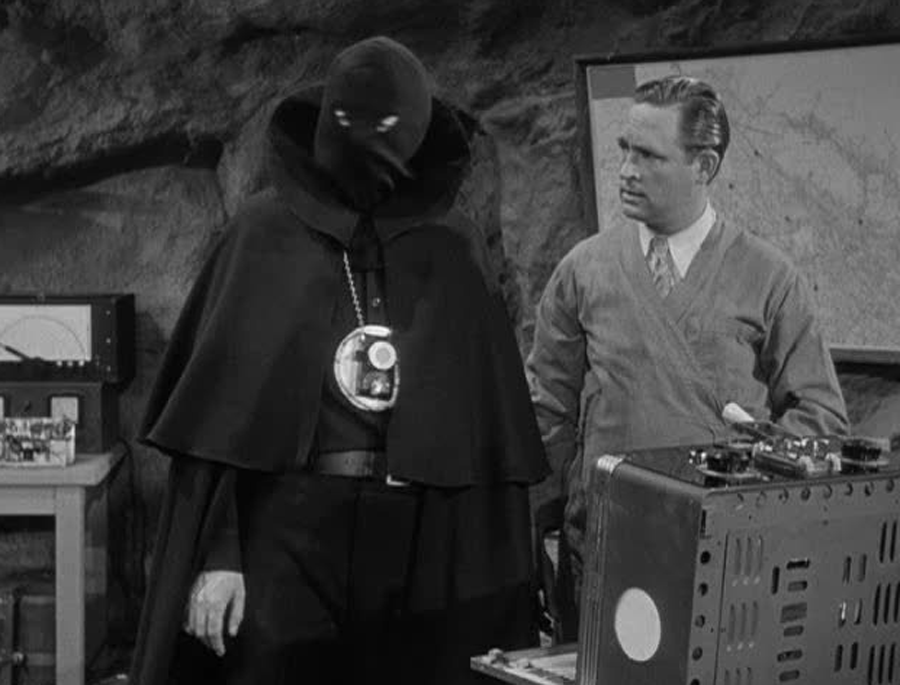Think you Know Batman? He's 83, and he was not always a gadget guy
The Bat signal was projected out to the sky from commissioner Gordon’s office, via a special TV- projector device (you can see it in the photo). Even though the device seemed to work day or night, Batman never saw it in the sky, because he was usually in The Batcave.
By Jim Drake
10 Things You May Not Have Known About the 1949 Batman Series
Seventy-three years ago a 15 episode Batman and Robin series made by Columbia Pictures ran in theaters, and through the miracle of today’s home video market those episodes can still give us a glimpse of what the crime-fighting action world was like before color TV.
“In 1939, DC Comics was looking for a new superhero after the wild success of Superman. Editor Vin Sullivan turned to cartoonist Bob Kane and asked him to design a new hero. Bob Kane along with writer Bill Finger would go on to conceive one of the most popular and enduring characters of the twentieth century—the Batman,” according to DCComics.com
By the way, copies of this first edition comic book of Batman are going for around $100,000.
If you’re still wrapping your head around 73 years, you may be surprised to learn that the 1949 series came after the 1943 series, and 1943 came after the 1939 comic book debut. That’s 83 years if you’re counting.
The 1949 incarnation is a good guy/bad guy crime-fighting drama, relying on old-fashioned police work to round up gangsters, and certainly not a techno-gadget filled escapade with dozens of unstable villains, like that of the 1960s TV episodes and the movies of the 80s, 90s and 2000s.
That said, one begins to see technology for fighting crime creeping into play in this 1949 series, and it will be so interesting to compare this series to the new “The Batman” 2022 movie, promised to be in theaters soon.
And for me, that means waiting for the new movie to come out on DVD, hopefully within 73 years.
Bat technology in these episodes was sparse. In the very last episode, Batman and Robin used personal two-way “radios” in one scene, but the complexity of the device looked Utility Belt prohibitive. The only other technology (besides some lab equipment in the cave) used to fight crime was a special breathing tube to prevent smoke inhalation.
In episode 13, Batman had a more complex Oxygen Inhaler, with a tank mounted on what was becoming his utility belt. At one point, though, he placed an entire welding torch apparatus in his speedos, right after cutting through a steel door. Ouch!
The character Vickie Vale is portrayed as the love interest for Bruce Wayne. Her job is as a photographer for Picture Magazine. No actual magazines or other coworkers are shown in any episode, but we do get to see the result of one photo she took, with a special Infra-red flashbulb.
The one and only villain throughout the series was the Wizard. He actually had more technology and electronic equipment in his cave than Batman had in his cave.
The “Batmobile” was a 1949 Mercury, and looked similar to every other car in the series. It was kept outside, under a Tree.
In episode 13, the Wizard creates the ability to become Invisible by combining electronic rays that are able to remotely control all types of transportation vehicles and electronic rays that neutralize all types of matter.
The Wizard
To get to the Wizard’s hideout cave, one must travel by submarine.
Batman, Robin, and the Wizard all wore Capes. The Wizard wore a full head-covering facemask to conceal his identity.
Batman and Robin’s costumes were kept in the Batcave - in the 2nd drawer of a 4-drawer metal file cabinet, and I mean the kind that you would typically see in a regular office.
Although there’s no mention of the Batcave actually being called “the Batcave,” whenever the Batcave is shown, you can distinctly see shadows of flying bats on the back rock wall of the Batcave.
The Bat signal was projected out to the sky from commissioner Gordon’s office, via a special TV- projector device (you can see it in the photo). Even though the device seemed to work day or night, Batman never saw it in the sky, because he was usually in The Batcave. Alfred the butler would look out the window of Wayne Manor, and then notify Batman, by telephone, of the signal’s activation.



